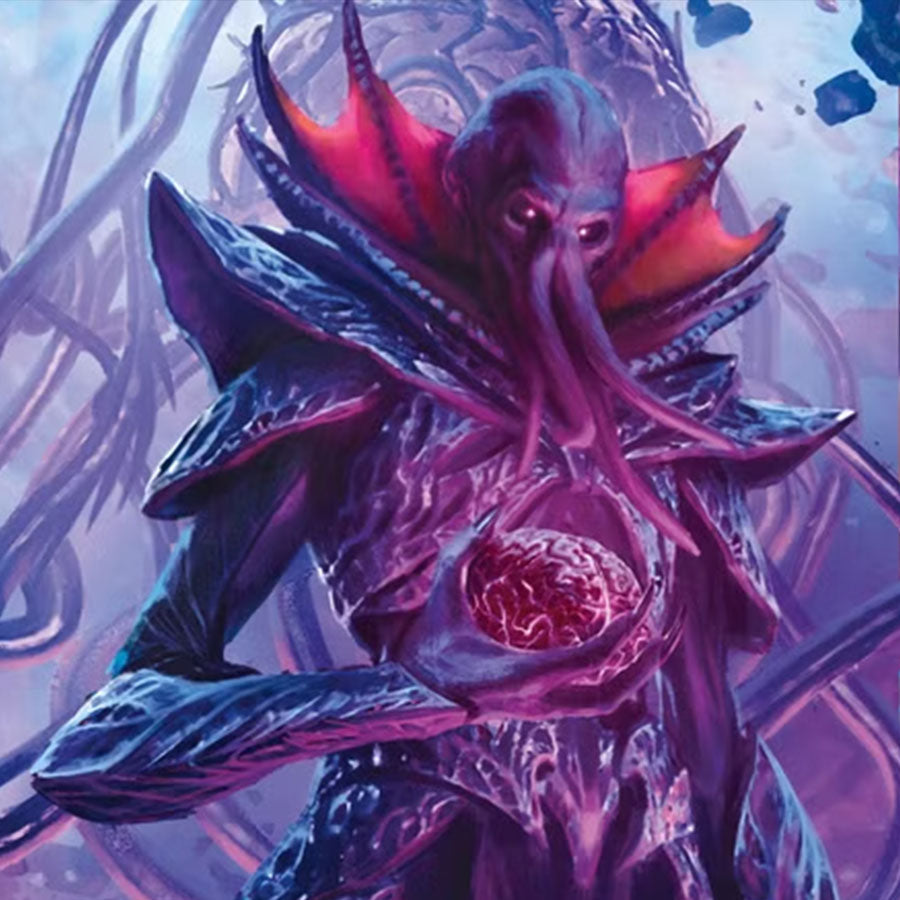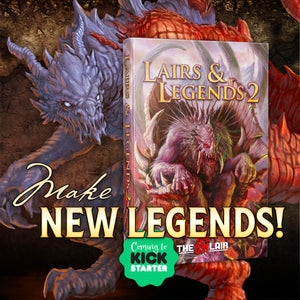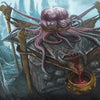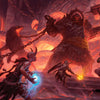The Truth About Mind Flayers | D&D Lore

By Luke Hart
You’ve been lied to. Again.
You were told mind flayers are just creepy squid-faced villains who eat brains and hang out in the Underdark. And yeah—they do eat brains. But that’s barely scratching the surface.
Because behind those tentacles is one of Dungeons & Dragons’ most mysterious, bizarre, and evolving monsters. They’ve been aliens. They’ve been psionic overlords. They’ve been horror icons, spacefaring empires, and even tragic remnants of a lost civilization. Depending on which edition you’re looking at, mind flayers might be from the Underdark… or from outside reality itself.
And the wildest part? Most of their best lore wasn’t even in the core books.
Today we’re digging into the real history of mind flayers—from their humble, terrifying beginnings in OD&D all the way to their resurgence in Baldur’s Gate 3. We’ll look at how the lore has changed, what got added, what got weird, and why the truth about illithids is way stranger than you’ve been led to believe.
Origins: Tentacles and Silence
The first time mind flayers showed up in Dungeons & Dragons, they weren’t part of some epic lore drop or multi-book arc—they were just quietly dropped into the pages of Eldritch Wizardry, the third supplement to the original 1974 OD&D ruleset.
And even in that barebones format, they stood out immediately.
They were described as “super-intelligent, man-shaped creatures” with heads that “most resemble a small octopus, with four tentacles which are used to strike their prey.” No stat block fluff, no tragic backstory—just a disturbing mental image and the implication that they were bad news.
What little lore we did get? They spoke only their “own arcane language and several other strange tongues,” supposedly belonging to “terrible races which inhabit regions far beneath the ground.” That’s it. That’s all you got. No mention of the Underdark. No psionics. No elder brains. Just a tentacle-faced nightmare that clearly didn’t belong anywhere near the surface world.
But even that tiny description? It was enough. The seeds had been planted—and mind flayers were about to become one of the most terrifying creatures in the D&D canon.
AD&D: Illithids, Cattle, and Spaceships
Curiously, mind flayers completely vanish from Basic D&D—no Holmes, no BECMI. If you were playing the simpler version of the game, the tentacle-faced brain slurpers were nowhere to be found. But in Advanced Dungeons & Dragons, they came back swinging.
The first real image of a mind flayer was in the original Monster Manual for AD&D 1st Edition. However, lore-wise? Still pretty sparse.
We’re told they “detest sunlight” and “consider the bulk of humanity—and its kin—as cattle to feed upon.” Which, you know, sets the tone. Mind flayers weren’t just evil—they were predators, and you were prey.
Then, in D1 – Descent into the Depths of the Earth, the name “Illithid” shows up for the first time. It’s not capitalized. It’s not emphasized. What’s more, it’s there as a wandering monster entry. But still, a seed planted.
But the real weirdness? That comes in S3 – Expedition to the Barrier Peaks.
This was the moment where mind flayers went full sci-fi. The adventure takes place in a crashed spaceship, disguised as a “metal cave.” Inside: androids, power armor, laser guns—and yes, mind flayers in high-tech space suits. The implication is clear: they’re not just weird—they’re aliens.
No major lore expansion beyond that—just the image of a mind flayer piloting a starship through deep space, disintegrating fools with ray guns. Early D&D didn’t care about genre purity. It just wanted to melt your brain—sometimes literally.
Until now, mind flayers were creepy and cool—but didn’t have much depth. That changed with The Ecology of the Mind Flayer by Roger Moore in Dragon Magazine #78.
Presented as a story where a party of adventurers meets a Githyanki informant, the article gives us the first real look into mind flayer lore.
We learn that mind flayers aren’t from any known world—they’ve been traveling the planes for so long, not even they remember their origin. They find new Prime Material planes, then use psychic projection and the Astral Plane to infiltrate and dominate them.
This article also introduces their most iconic enemies: the Githyanki. It’s the first time we see the ancient war between the two races—one that would become a major pillar of mind flayer lore going forward.
It wasn’t a full rewrite, but it gave the flayers context, history, and interplanar ambition. They weren’t just brain-eating monsters anymore. They were a threat to realms.
AD&D 2nd Edition: Elder Brains and Astral Empires
Mind flayers got a bit of a glow-up in 2nd edition, but the changes came in pieces.
They first appear in the Monstrous Compendium and later the Monstrous Manual, where their lore is still fairly light. We get more emphasis on their extreme arrogance, their obsession with eating the brains of intelligent beings, and the solidifying of “illithid” as their proper name. The Manual does introduce a cool twist: some illithids are born truly psionic, and they’re considered the elite—the purest form of their species.
Most importantly, though, these books introduce the concept of the elder brain: a massive, communal brain that lives in a pool at the center of every illithid colony. It stores knowledge, controls the hive, and serves as both leader and god to its mind flayer subjects.
But if you want to see 2nd edition really define them, you have to look at Spelljammer.
Here, mind flayers aren’t just lurking in the Underdark—they’re a full-blown Astral empire. They enslave, experiment on, and wage war against other spacefaring races. And this is where we get their most iconic vehicle: the nautiloid, a living ship shaped like a giant squid, capable of sailing the stars. Not quite sci-fi, not quite fantasy—just very illithid.
3rd Edition: Psychology, Psionics, and the Lords of Madness
When Wizards of the Coast took over with 3rd Edition, they didn’t do much with mind flayers at first.
The Monster Manual kept them mysterious, but added a few updates—most notably, it described the elder brain in more detail. Instead of being one giant mind, it was now a briny pool filled with the brains of every deceased illithid in the colony—a psychic soup of dead geniuses. We also got our first nod to “mind flayer sorcerers,” though their magic was still heavily flavored with psionics.
Then came Lords of Madness—and that’s when things got deep.
This supplement didn’t explain their origins (in fact, it leaned hard into the mystery), but it gave us the most detailed look yet at how mind flayers think. They’re emotional—intensely so—but they bury those feelings to appear cold and in control. And what they do feel is chilling: anger, fear, envy, hate, shame, and contempt. Their entire society is shaped around suppressing these emotions, pretending to be above them, while privately simmering with negativity.
Lords of Madness also solidified the classic elder brain: one massive brain floating in a pool, formed from the merged minds of the colony’s dead.
We got details on their psionic “magic,” alien artifacts like resonance stones and psionic seals, and for the first time, a fully realized connection to the children of Gith—their former slaves, now their fiercest enemies. It even hints at something deeper: that mind flayers were originally created by ancient, unknown progenitors—beings so hated by the illithid that they were eventually destroyed.
3rd Edition didn’t rewrite mind flayers—it just peeled back the veil a little, revealing a society that’s not just terrifying because of its powers… but because of the cold, calculating cruelty at the heart of its culture.
4th Edition: The Far Realm Connection
4th Edition didn’t add much new to mind flayer lore, but it did make one important shift: it firmly linked their origin to the Far Realm—a place of madness, alien geometry, and incomprehensible logic.
According to this edition, mind flayers “came to the natural world from the Far Realm long ago.” They’re usually found in the Underdark, only venturing to the surface for specific, secretive missions.
It’s a simple update, but it locked in the idea that illithids aren’t just alien—they’re from outside reality itself.
5th Edition: Ceremorphosis and the Grand Design
By the time we reach 5th Edition, mind flayers have fully evolved into the version we know today.
They show up in a few places—like the Spelljammer books, which reinforce their 2nd edition spacefaring roots—but the definitive lore drop comes from Volo’s Guide to Monsters.
The chapter titled “Mind Flayers: Scourge of Worlds” ties together decades of lore. It casts the illithid as a culture in decline, fugitives from a war they lost to the githyanki. Some sources even call them a race on the brink of extinction. But Volo’s introduces a twist: maybe they’re not losing. Maybe they moved themselves into the future, which would explain their fragmented culture and mysterious absence.
This is also where we get the first full explanation of ceremorphosis—the horrifying process by which mind flayers implant tadpoles into other humanoids to reproduce. The concept existed before, but this book gave it form—and the first official image of a mind flayer tadpole.
It also introduces a cultural taboo: magic. Arcane spellcasting is considered heretical to illithid society, and mind flayers who practice it are hunted and executed.
Finally, we learn of the Grand Design—the secret plan for illithid survival, resurgence, and eventual dominion over all other life. A quiet obsession that’s recently gotten the spotlight thanks to Baldur’s Gate 3.
In 5e, mind flayers aren’t just monsters. They’re remnants of a fallen empire, biding their time, still dreaming of conquest.
Pop Culture: From the Underdark to the Upside Down
Mind flayers have officially escaped the dungeon.
In recent years, they’ve made a huge leap into mainstream pop culture—thanks in large part to a couple of high-profile appearances.
First, there’s Stranger Things. In Season Two, the kids name the show’s new big bad “The Mind Flayer,” and while the creature doesn’t share the illithid’s look or psionic lore, the name stuck. Even after Vecna took the spotlight in later seasons, the Mind Flayer remained a looming presence—cementing the term in the public consciousness.
Then came Baldur’s Gate 3 from Larian Studios—a full-on, officially licensed D&D video game that didn’t just include mind flayers—it centered them. The entire plot revolves around ceremorphosis, mind flayer tadpoles, and the illithid’s “Grand Design.” For many players, it was their first real introduction to what mind flayers are, how they think, and why they’re so terrifying.
Thanks to these appearances, mind flayers aren’t just a classic monster anymore. They’re a modern icon of D&D horror.
WHICH VERSION DO I PREFER?
Though I’ve been playing D&D since the 90s, my access to source material has been rather limited over the years. So, the only version of the mind flayer that I’m super familiar with is that of D&D 5e, and I rather like it. The Elder Brain, the tadpoles, the psionics, the taboo on magic—I think they are all really cool. And the whole bit about OD&D including sci-fi spaceships in fantasy—that’s just not to my personal taste. I prefer to keep my genres separate.
The Ultimate D&D 5e Resource Anthology
Even as a veteran dungeon master, I'm often overwhelmed with everything I need to do to prep for a game. And I suspect others might feel the same way. That's exactly why my team and I created Lairs & Legends 2 and Loot & Lore 2.
If you’re looking for loads of 5e adventures that you can prep in under 30 minutes or elements such as traps, puzzles, and encounters that you can drag and drop into your game at a moment’s notice, we have you covered!
With Lairs & Legends 2 and Loot & Lore 2, you’ll get over 700 pages of D&D 5e resources:
- 33 Adventures
- 100+ Monsters
- Encounters
- Traps
- Puzzles
- and more!
Everything is designed to be EASY TO USE and QUICK TO PREP for your game. Our goal is to make game masters’ lives easier, not more complex!
Don’t spend another moment frustrated and overwhelmed as a GM. Pick up the Lairs & Legends 2 and Loot & Lore 2 today and find out how much easier being a GM can be!
-
Posted in
Game Master How-To Articles








